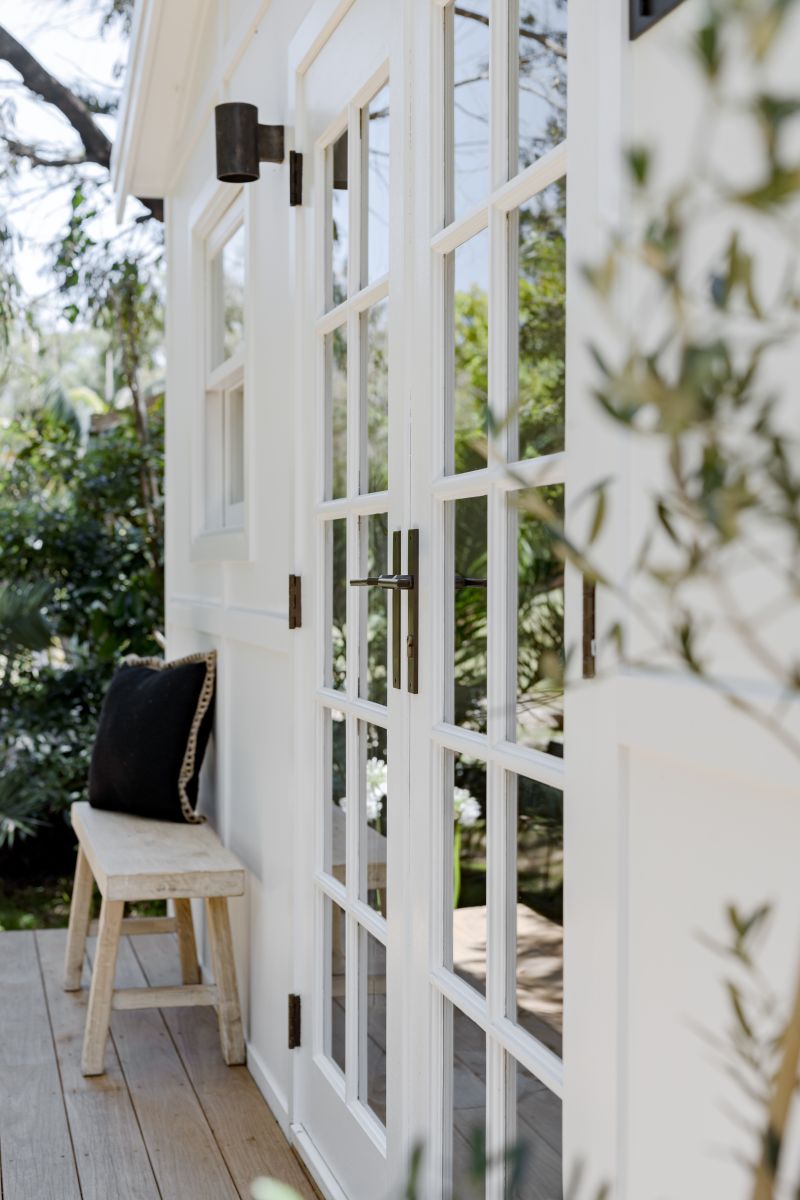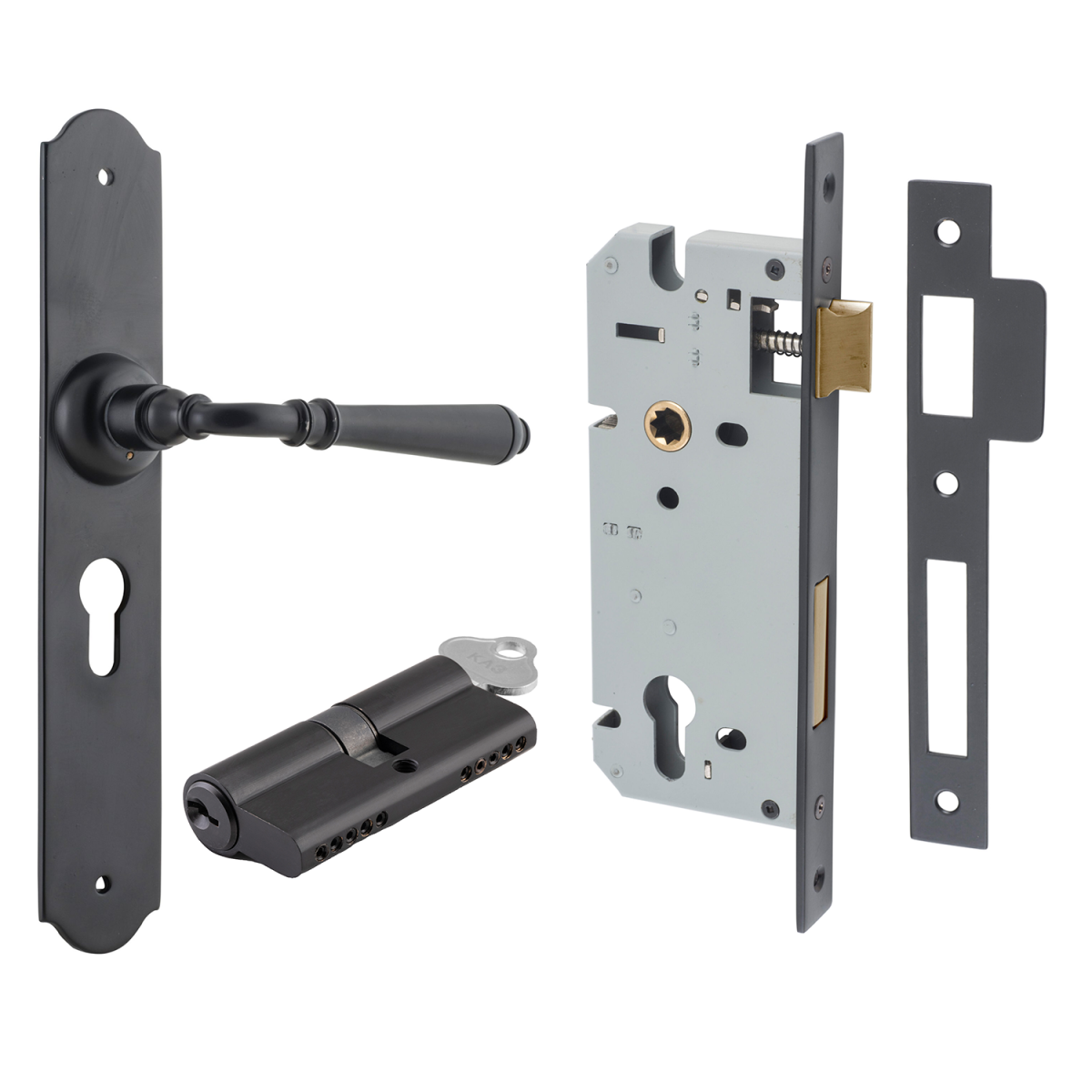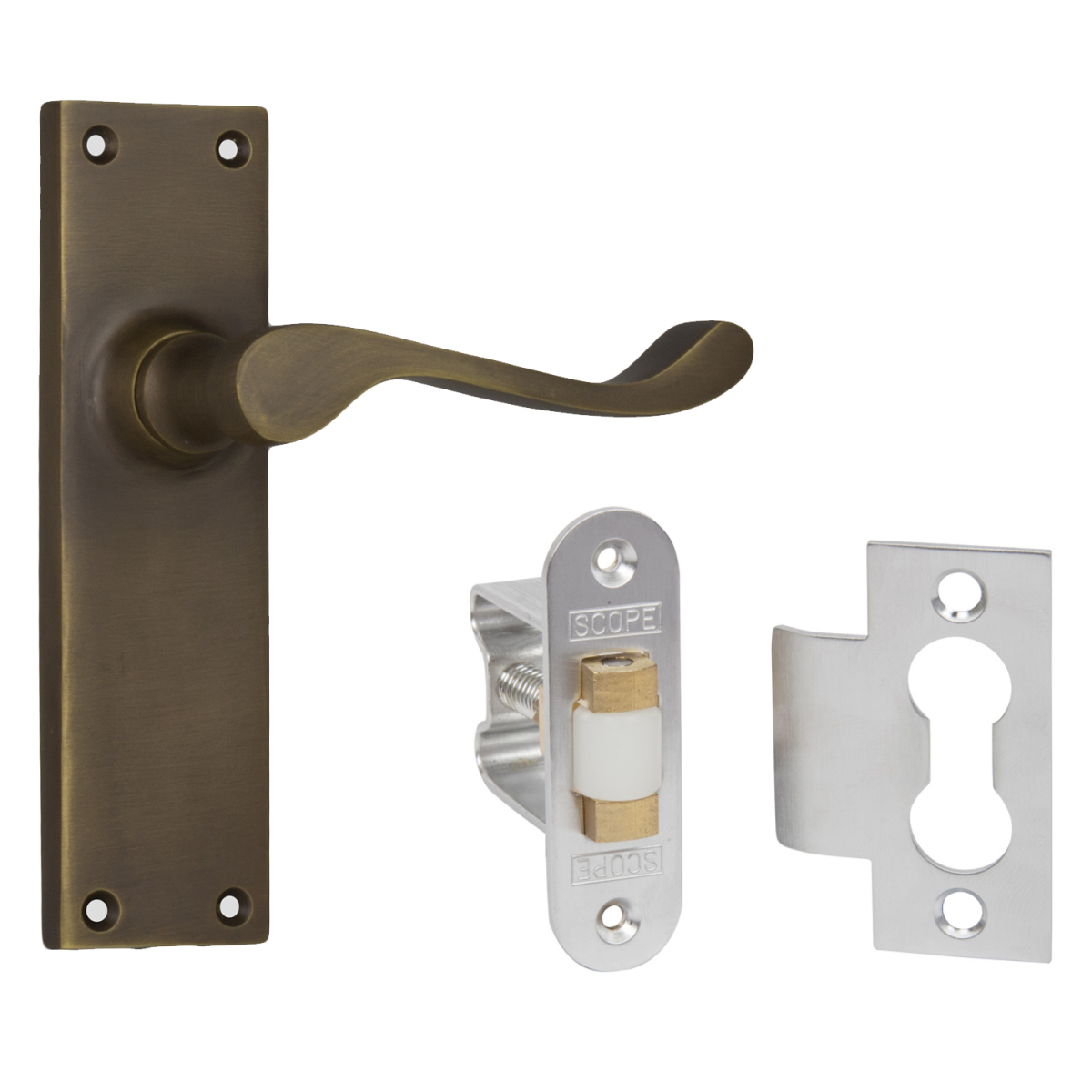A French door's hardware is not only functional, but it also adds to its aesthetics and style. There are endless choices for French door hardware, from traditional handles and knobs to more modern options like lever handles or flush pulls. We'll take a closer look at some of the most popular options.
Timeless Elegance and Style with French Door Handles
French doors are renowned for their contribution to traditional homes. They offer an elegant touch to various designs, such as Hamptons, Coastal, Country, and Rustic. Their glass panelling allows plenty of natural light inside while maintaining privacy. To create the perfect atmosphere, picking the right French door hardware is essential; therefore it is important to comprehend some key features of your French doors before selecting handles and other hardware. One of the most significant features to consider is the door type, as French doors come in various designs. They can be hinged or sliding and can open inward or outward. This will determine how easy it is to access the door from both sides, which in turn will help you decide on a handle style that suits you best. Additionally, it’s important to choose handles that are compatible with your lock system and have a comfortable grip for opening and closing the doors safely. Apart from the handle type, you might also want to take into account the material and colour of your door hardware. Do you prefer a rustic look with metal handles or do you opt for something more sophisticated such as crystal knobs? Moreover, there are various finishes available such as brass, chrome, bronze etc., which can give your French doors an extra touch of sophistication. Ultimately, selecting the right hardware should reflect your personal style and provide a practical solution that will last for years to come!
What Are The French Door Types
There are three types of French doors: sliding doors, rebated doors, and leaved doors.
Sliding Doors: Sliding doors consist of leaf doors that smoothly glide together, creating a flush surface.
Rebated Door: The Rebated Door is a swinging door that features a groove or channel at the end. This allows it to snugly close onto the other door, creating an overlap lip.
-These rebate kits enable proper functionality of Mortise Locks and Roller Locks on double doors with rebates.
Leaved Doors: Leaved doors are swinging doors where two leaf doors meet squarely, similar to a sliding door.
These are the most traditional type of French door and typically feature decorative glass or wood carvings along each panel. The panels can either be inset into the frame or hung on hinges like an ordinary door.
No matter what type of French door you need, they are all designed to bring a touch of elegance and romance to any home. While sliding doors are the most popular choice for modern homes, leaved doors offer a classic look that will never go out of style. And with rebated doors, you can get the best of both worlds: beauty and practicality. If your goal is function or fashion no matter, there's sure to be a French door that will fit your needs perfectly!
Hardware For New Or Refurbished French Doors
Considering Types Of Doors: When choosing handles and hardware, it's important to consider if your doors are brand new or repurposed.
New: You can get more options when installing new French doors than repurposed ones. It is important to consider the space available within the door's glass panelling to avoid damaging the glass during installation.
Refurbished: When repurposing doors, determine the diameter of any existing boreholes. Additionally, determine whether the wood panel where the hardware will be installed is solid.
Exploring French Door Hardware Options
After considering the factors above, you can explore various hardware options for your French doors. You can choose from different types of handles, knobs, and locks. Handles provide easy access to the doors while knobs are more decorative and add an additional element of style to the door. When it comes to locks, you could go with a traditional deadbolt or opt for something like a cylinder lock that gives you added security. You may want to consider purchasing dummy hardware sets so that your French doors have matching handles on both sides. Whatever options you decide on, make sure they fit in well with your overall french door hardware design aesthetic and offer optimal security for your home!
Here are some French door hardware suggestions to consider from Keeler Hardware:
Entrance pull handles (key lockable)
Tradco Bar Pull Handle - SKU : TRA2926
Iver Euro Roller Mortice Lock - SKU : TRA6030
Tradco Iver Euro Double Cylinder - SKU : TRA21600
or Tradco Iver Euro Cylinder Key Thumb 5 Pin - SKU : TRA21610
Iver Forged Round Euro Escutcheon - SKU : TRA9300
The two types of entrance pull handles are face-fixed entrance pulls, which are screwed from the front, and back-to-back entrance pulls, which are screwed on both sides.
Long plated levers for locking:
Tradco Reims Lever on Long Backplate Euro - SKU : TRA9620E85
Iver Euro Mortice Lock - SKU : TRA6066
Tradco Iver Euro Cylinder Double Cylinder - SKU : TRA21653
or Tradco Iver Euro Cylinder Key Thumb 5 Pin - SKU : TRA21613
Use a matching dummy set on the other side of the door to maintain aesthetic balance. Long plated lever sets provide enhanced security for external doors.
Non-locking latching options:
Scope Roller Bolt Adjustable Tension SKU : SCORB152SC
Tradco Victorian Door Lever Handle SKU : TRATD0782
Sets of dummies SKU : TRATD0782
For doors that need to latch without locking, the Scope Roller Bolt Latch - SKU : SCORB152SC well with entrance pulls and dummy lever sets. Passage levers with internal tongues are ideal for keeping doors shut.
Consider these additional products to complement your French doors:
Use flush bolts on one side of the door while using the other side for entry or exit.
Brio Flush Bolt Square Edge - SKU : BRO456SN
Brio Flush Bolt Square Lockable - SKU : BRO456ESN1
Brio Flush Bolt Round Edge - SKU : BRO456RSN
To achieve a cohesive look, choose hinges that match your hardware finishes.
You can enjoy the aesthetic appeal of French doors while maintaining peace of mind by equipping them with strong locks, flush bolts, and reliable door hardware.
There is no doubt that French doors enhance any home's visual appeal and may even increase its value. French door handles and hardware create a timeless and sophisticated style that complements various interior design themes. Make your French doors the focal point of your living room by choosing wisely.
What We've Learned About French Doors
Our experience in the door hardware industry has led us to come across a lot of the same questions, so we thought it might be helpful to compile a list of the most frequently asked French door hardware questions.

Should French Doors Have Handles On Both Sides?
It really depends on the purpose for which they are being installed. If you are installing interior French doors, then it may be best to have handles on both sides so that people can open and close them from either side. However, if you are looking to install exterior French doors, then having front door handles only on the inside makes more sense as this will help keep your home secure. In any case, it is important to consider how often these doors will be used when deciding whether or not to put handles on both sides of them. No matter what you decide, it is important that the handles are easy to use. This means that they should be sturdy yet comfortable to hold and use, making sure that both sides of the door can easily be opened and closed. Choosing french door locks and handles for both sides is also a great way to secure your home while still maintaining the style and beauty of your French doors. Regardless of the purpose for which French doors are being installed, it is important to consider the safety and security aspect to ensure that your home remains safe. For this reason, having handles on both sides may be a good idea in order to make sure that people can access them from either side. Additionally, if you have children or elderly living in your home then having handles on both sides will allow them to open and close the door without any difficulty. Ultimately, deciding whether or not French doors should have handles on both sides depends largely upon their intended use.
How To Choose Door Locks For French Doors?
When it comes to choosing the right door locks for French doors, there are a few different options to consider. One of the most popular choices is a mortise lock, which is installed in the door frame and consists of an internal latch connected to two external knobs or handles. This type of lock provides strong security and works well with any style of French doors. Another option is a deadbolt lock, which requires a key for operation and also provides excellent security. It can be used on both inward-opening and outward-opening French doors but may require some extra hardware depending on your specific situation. If you're looking for something simpler, you can opt for handle sets that come with built-in locks, eliminating the need for multiple separate components; however these are not as secure as mortise locks or deadbolts because they don't have an internal mechanism that engages when the handle is turned from outside. When installing a new lock system it's important to take into account any existing hardware already installed on the French doors so there isn't any interference between them. Be sure to pick out finishes and colours that match with the overall look of your space so you can feel confident knowing you've chosen secure yet attractive hardware for your home or business's exterior entrance points.
Can You Put A Smart Lock On French Doors?
Absolutely. Smart locks are designed to fit all types of doors, including French doors. Most smart lock manufacturers offer kits for French doors that include a special adapter plate and other hardware necessary for proper installation. Installing a smart lock is straightforward, but it’s always best to consult with an expert if you need assistance or have any questions about the installation process. Once installed, you can enjoy the convenience of having one keyless access point on each side of your French door system while also enjoying the security benefits that come from having a secure locking system in place at all times. Another key benefit of having a smart lock on your French doors is the ability to remotely control the locks. Many of these systems feature an app that allows you to easily manage access rights from anywhere in the world. This means you can grant or revoke access at any time, even when away from home. Additionally, many models also allow for automated locking and unlocking at specified times so you never have to worry about forgetting to secure your space after entering or leaving. Smart locks provide homeowners with added peace of mind knowing their property is always secure and under their watchful eye—even when they’re not there!
What Door Hardware Should You Choose For French Doors In An Entryway?
French doors provide a beautiful way to enter your home, so it's important to choose locks and handles that will match the style of your doors. You should also take into account the strength of the doors. Look for locks with deadbolts designed for French door exterior use, as these provide extra security against forced entry. Make sure all entrance hardware you select is corrosion-resistant so it can withstand outdoor elements like humidity and rain. Consider choosing an entrance door handle set that is easy to grab, especially if elderly family members live in the home or there are small children who need to be able to open them easily. Think about the overall design of your entryway. Your locks and handles should complement the style of French doors you have chosen for your home, as well as other accents like door knockers, house numbers or lights. By taking into account these factors when choosing a lock and handle system for French doors, you can ensure they will be both secure and attractive additions to your home entrance. For the interior of your French doors, it is important to select a handle that you can easily reach and manipulate. Make sure the door hardware you choose will be easy to use for all members in your home, especially if they have limited mobility or strength. If privacy is an issue, opt for locks with built-in thumb-turns so no one needs a key to open them from the inside. And consider choosing lever handles instead of knobs as these are easier to turn without having to twist your wrist or grip too tightly.
Why Are French Door Knobs In The Middle?
French door knobs are typically placed in the middle of a door because this is the most ergonomic location. When you place the handle in the centre, it allows for an even distribution of weight when pulling or pushing open a door. Additionally, having a central knob makes it easier to grab and turn with one hand while carrying items with your other. Furthermore, it encourages people to use both hands on either side when entering or leaving a room; this reduces wear and tear on hinges from only opening on one side. The centre location of French door knobs also helps to make them look more aesthetically pleasing. Rather than competing with the design or colour of a door, they blend into it and act as an understated but necessary feature. This is especially true for doors that have intricate designs; having the knob in the middle prevents it from detracting from these details. Overall, the centre placement of French door knobs is a practical and aesthetically pleasing choice for any home. It allows for easier access and encourages even weight distribution when opening or closing the door. Plus, it can help to enhance the overall look of your room by blending in with its design rather than distracting from it.
What Is The Lock On A French Door Called?
A French door lock is typically referred to as a mortise lock. These locks are generally set into a rectangular hole cut in the edge of the door and use a deadbolt-style locking mechanism to secure the two halves of the door together. Mortise locks can be found on both interior and exterior doors, although they may vary slightly depending on their function and location. Many people choose this type of lock because it is extremely durable, providing extra security for both residential and commercial applications. Furthermore, these types of locks are usually quite easy to install with minimal tools required; however, some professional installation services may be necessary if you’re looking for additional security features such as keyless entry systems or other advanced options. Mortise locks are also available in a variety of styles and finishes, making them a great choice for adding style to your doors. No matter if you’re looking for something traditional or more modern-looking, there is likely a mortise lock that will fit your needs perfectly. Furthermore, these locks can be purchased with either deadbolts or handles; the latter offering extra convenience for those who don't want to use their key all the time. So if you're looking for an efficient way to secure your French door(s) without sacrificing aesthetics then consider investing in one of these reliable mortise locks today!
Can You Replace Handles On French Doors?
Yes, you can replace the handles on French doors. Depending on the type of handle and door frame, this may require different tools or supplies. Generally speaking, French doors come with two door knobs that are attached to a metal plate called a mortise lock, which is mounted inside the door’s edge. To remove an old handle and install a new one, you first need to unscrew the old handle from its mounting screws and then carefully pry off the faceplate covering the mounting screws. Once these steps are complete, simply place your new handle in position and secure it with mounting screws before replacing the faceplate cover. Keep in mind that if your French door has an electronic locking system installed, you will need to consult with a professional locksmith for help installing or replacing any hardware components related to security systems. In addition, you may also need to replace the hinges on French doors. This is because old or damaged hinges can cause misalignment of the door panels and impair their performance. You will need to unscrew one hinge at a time and replace it with an identical piece before repeating the process for remaining hinges. If any of your French doors are made from wood, be sure to use only wooden screws when replacing any hardware components as metal screws can easily strip out the softwood material. Installing new hinges is relatively straightforward but if you encounter any problems during installation or have questions about the process, consult with a professional carpenter who specialises in French doors.


.png)

